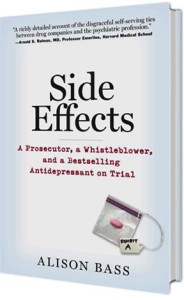I’ve been reading Dr. David Healy’s new book, Pharmageddon, and while some of it may seem like old news, I was struck by his fresh analysis of how the pharmaceutical industry has turned the original purpose of clinical trials inside out. As Healy, a noted historian of psychiatry who was among the first to call attention to the side effects and relative ineffectiveness of the SSRI antidepressants points out, clinical trials were originally devised by academic researchers to debunk snake-oil treatments. But the drug industry, who knows a marketing opportunity when it sees one, has managed to market randomized clinical trials as the “gold standard” of research and convince regulatory agencies (such as the FDA) and doctors that if a trial shows that a new drug is more effective than a placebo, then it must be so.
The major flaw with this so-called evidence-based approach (what Healy snidely refers to evidence-biased medicine) is that the drug companies have perfected the art of publishing only those handful of clinical trials that show efficacy and making sure that all the negative trials that didn’t show efficacy of the same drug are not published. As Jonah Lehrer points out in his controversial New Yorker piece, if you do enough clinical trials, one or two are bound to show some statistical significance, particularly when you skew the data by changing primary outcome measures mid-stream and miscoding patient data (as researchers did with Paxil study 329). So if you only publish those supposedly positive trials and hide the rest (as companies did time and again with Paxil and other SSRI antidepressants, along with atypical antipsychotics like Risperdal and Zyprexa and many other drugs), then it’s easy to convince doctors that these drugs are safe and effective when they are anything but.
Under a law passed by Congress in 2007, drug companies are supposed to post the data from all their clinical trials (unpublished as well as published) on publicly available websites, so at the very least doctors intent on finding the full story on a particular treatment can sift through the data themselves. This, of course, is not an easy exercise, particularly for busy doctors and consumers who don’t know what they’re looking for among the reams of technical data posted. The other problem is that many companies (particularly those not based in the U.S.) are not complying with this law. As Healy points out in Pharmageddon, in reality, no one in the scientific community, not even the individual researchers involved in these studies, gets to see the raw data from multi-site clinical trials except the clinical research organization (CRO) under contract to the maker of the drug.
Take, for example, the flu medication, Tamiflu. Earlier this week, in an opinion piece posted on New York Times online, two researchers, one from John Hopkins and the other affiliated with the Cochrane Collaboration, wrote about their efforts to obtain all the raw data in clinical trials of Tamiflu. Based on the limited clinical data published in medical journals, they reported, it looked as if “the country’s most widely used and heavily stockpiled influenza drug appeared no more effective than aspirin.” After publishing that conclusion in the British Medical Journal in 2009, they said, “Roche promised access to data about Tamiflu from 10 clinical trials, eight of which had not been published a decade after completion.” But the drug maker has yet to comply with that request.
Why does all this matter? As one very witty doctor/epidemiologist put it in a recent TED talk — see this video — if as the evidence seems to suggest, Tamiflu only shortens the duration of a flu for four hours but does not reduce the risk of serious complications (like pneumonia and death) as Roche says it does, then billions of dollars should probably not be spent stockpiling the drug and prescribing it to patients around the world. Indeed, according to Peter Doshi and Tom Jefferson, the researchers who wrote the opinion piece in the Times website, say, “there is suggestive evidence that Tamiflu interfered with the body’s ability to produce antibodies against influenza — which could affect the body’s response to influenza vaccine and its ability to fight off future influenza infections.”
The FDA has all the raw data on Tamiflu and could clear up the question of its efficacy easily, but for reasons I and most of the scientific community don’t understand, it will not release the data on any drug without the express permission of the drug makers. As Doshi and Jefferson say, “the F.D.A. — guardian of arguably more trial data than any other entity in the world — appears stuck in the era of data secrecy.”
And who suffers? As usual, it’s us: the patients and consumers who are prescribed drugs that not only don’t work but can have dangerous side effects.
Hat tip to Marilyn Mann who first posted the Tamiflu opinion piece on Facebook.



I wish more people were reporting on Pharmageddon like this. I think Healy outdid himself with his analysis of the history and perversion of Clinical Trials. Who would’ve thought that the addition of efficacy to the traditional task of safety could have run so far amok? But the whole book is filled with ‘pearls.’